Open Innovation and User Innovation: A Business Marketing Report
VerifiedAdded on 2022/10/02
|11
|3105
|256
Report
AI Summary
This report examines open and user innovation within the context of business marketing, focusing on the shift towards customer-centric approaches and the significance of user insights in driving innovation. It begins with an introduction to open innovation and user innovation, highlighting their relationship and the evolution from traditional R&D models. The research objectives include understanding the importance of customer innovation, addressing challenges in open communication, and exploring the pros and cons of user innovation. The report utilizes secondary data and qualitative analysis to discuss findings, including the methods companies use to gather customer feedback, the challenges of open communication, and the importance of selecting the right partners. It also explores issues such as cultural challenges, integrating user insights, and protecting intellectual property rights. The report concludes by emphasizing the benefits of open innovation, such as building a stronger community, staying ahead of competition, and reducing costs, while also acknowledging the challenges associated with implementation. The report also discusses the importance of adapting to user innovation techniques, and how businesses can leverage user feedback to improve their products and services. Finally, it discusses the future of user innovation and the importance of staying connected with customers to meet their needs.
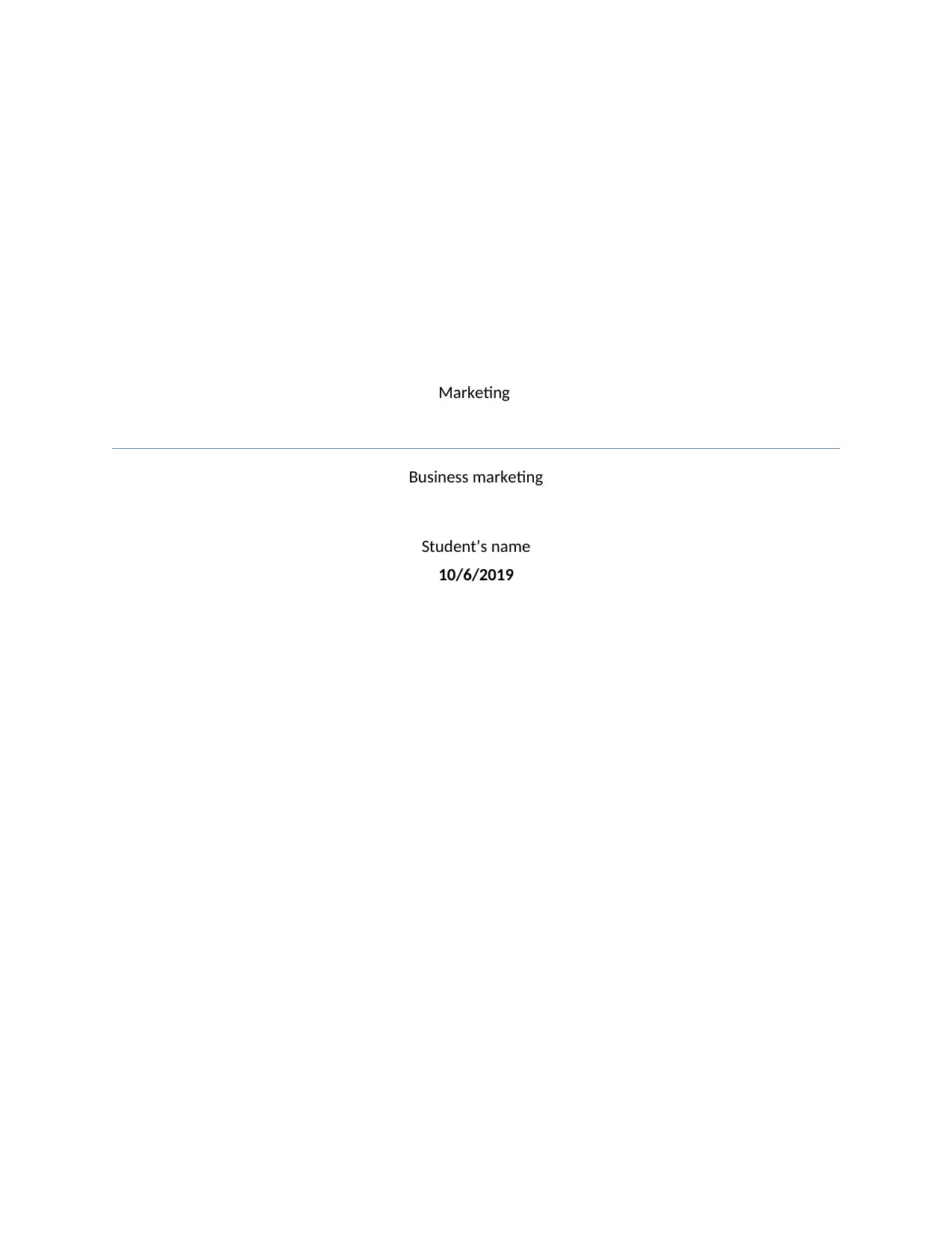
Marketing
Business marketing
Student’s name
10/6/2019
Business marketing
Student’s name
10/6/2019
Paraphrase This Document
Need a fresh take? Get an instant paraphrase of this document with our AI Paraphraser
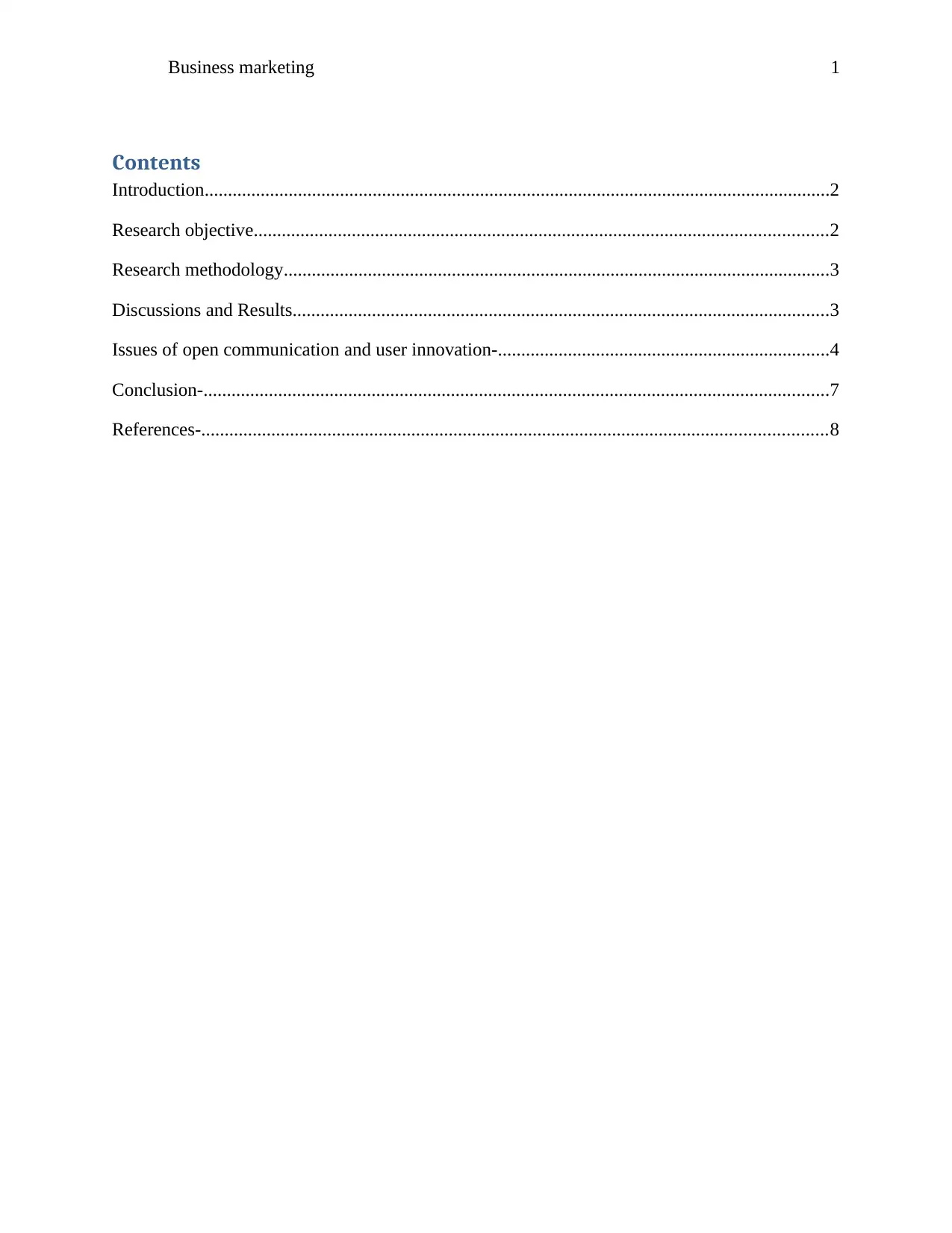
Business marketing 1
Contents
Introduction......................................................................................................................................2
Research objective...........................................................................................................................2
Research methodology.....................................................................................................................3
Discussions and Results...................................................................................................................3
Issues of open communication and user innovation-.......................................................................4
Conclusion-......................................................................................................................................7
References-......................................................................................................................................8
Contents
Introduction......................................................................................................................................2
Research objective...........................................................................................................................2
Research methodology.....................................................................................................................3
Discussions and Results...................................................................................................................3
Issues of open communication and user innovation-.......................................................................4
Conclusion-......................................................................................................................................7
References-......................................................................................................................................8
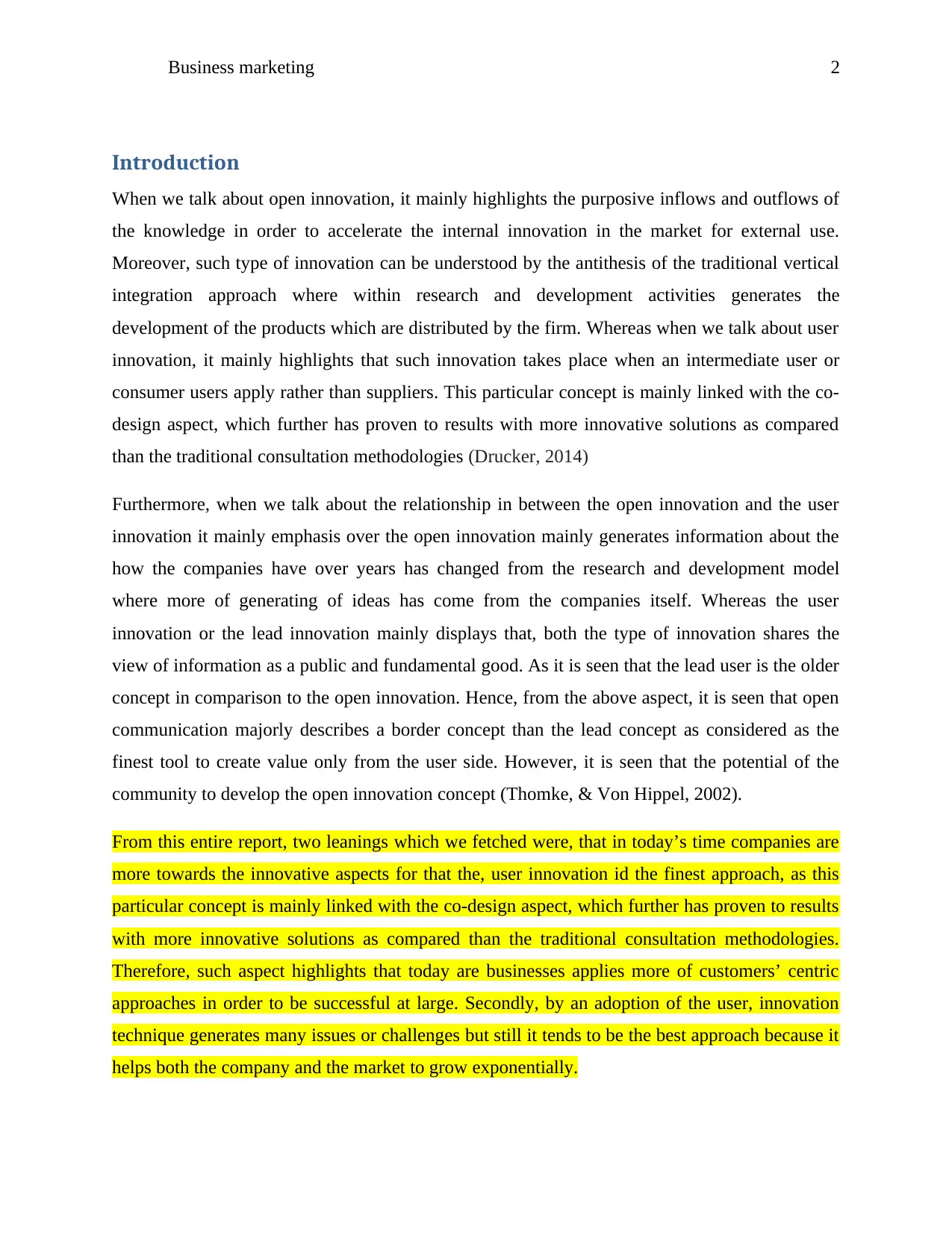
Business marketing 2
Introduction
When we talk about open innovation, it mainly highlights the purposive inflows and outflows of
the knowledge in order to accelerate the internal innovation in the market for external use.
Moreover, such type of innovation can be understood by the antithesis of the traditional vertical
integration approach where within research and development activities generates the
development of the products which are distributed by the firm. Whereas when we talk about user
innovation, it mainly highlights that such innovation takes place when an intermediate user or
consumer users apply rather than suppliers. This particular concept is mainly linked with the co-
design aspect, which further has proven to results with more innovative solutions as compared
than the traditional consultation methodologies (Drucker, 2014)
Furthermore, when we talk about the relationship in between the open innovation and the user
innovation it mainly emphasis over the open innovation mainly generates information about the
how the companies have over years has changed from the research and development model
where more of generating of ideas has come from the companies itself. Whereas the user
innovation or the lead innovation mainly displays that, both the type of innovation shares the
view of information as a public and fundamental good. As it is seen that the lead user is the older
concept in comparison to the open innovation. Hence, from the above aspect, it is seen that open
communication majorly describes a border concept than the lead concept as considered as the
finest tool to create value only from the user side. However, it is seen that the potential of the
community to develop the open innovation concept (Thomke, & Von Hippel, 2002).
From this entire report, two leanings which we fetched were, that in today’s time companies are
more towards the innovative aspects for that the, user innovation id the finest approach, as this
particular concept is mainly linked with the co-design aspect, which further has proven to results
with more innovative solutions as compared than the traditional consultation methodologies.
Therefore, such aspect highlights that today are businesses applies more of customers’ centric
approaches in order to be successful at large. Secondly, by an adoption of the user, innovation
technique generates many issues or challenges but still it tends to be the best approach because it
helps both the company and the market to grow exponentially.
Introduction
When we talk about open innovation, it mainly highlights the purposive inflows and outflows of
the knowledge in order to accelerate the internal innovation in the market for external use.
Moreover, such type of innovation can be understood by the antithesis of the traditional vertical
integration approach where within research and development activities generates the
development of the products which are distributed by the firm. Whereas when we talk about user
innovation, it mainly highlights that such innovation takes place when an intermediate user or
consumer users apply rather than suppliers. This particular concept is mainly linked with the co-
design aspect, which further has proven to results with more innovative solutions as compared
than the traditional consultation methodologies (Drucker, 2014)
Furthermore, when we talk about the relationship in between the open innovation and the user
innovation it mainly emphasis over the open innovation mainly generates information about the
how the companies have over years has changed from the research and development model
where more of generating of ideas has come from the companies itself. Whereas the user
innovation or the lead innovation mainly displays that, both the type of innovation shares the
view of information as a public and fundamental good. As it is seen that the lead user is the older
concept in comparison to the open innovation. Hence, from the above aspect, it is seen that open
communication majorly describes a border concept than the lead concept as considered as the
finest tool to create value only from the user side. However, it is seen that the potential of the
community to develop the open innovation concept (Thomke, & Von Hippel, 2002).
From this entire report, two leanings which we fetched were, that in today’s time companies are
more towards the innovative aspects for that the, user innovation id the finest approach, as this
particular concept is mainly linked with the co-design aspect, which further has proven to results
with more innovative solutions as compared than the traditional consultation methodologies.
Therefore, such aspect highlights that today are businesses applies more of customers’ centric
approaches in order to be successful at large. Secondly, by an adoption of the user, innovation
technique generates many issues or challenges but still it tends to be the best approach because it
helps both the company and the market to grow exponentially.
⊘ This is a preview!⊘
Do you want full access?
Subscribe today to unlock all pages.

Trusted by 1+ million students worldwide
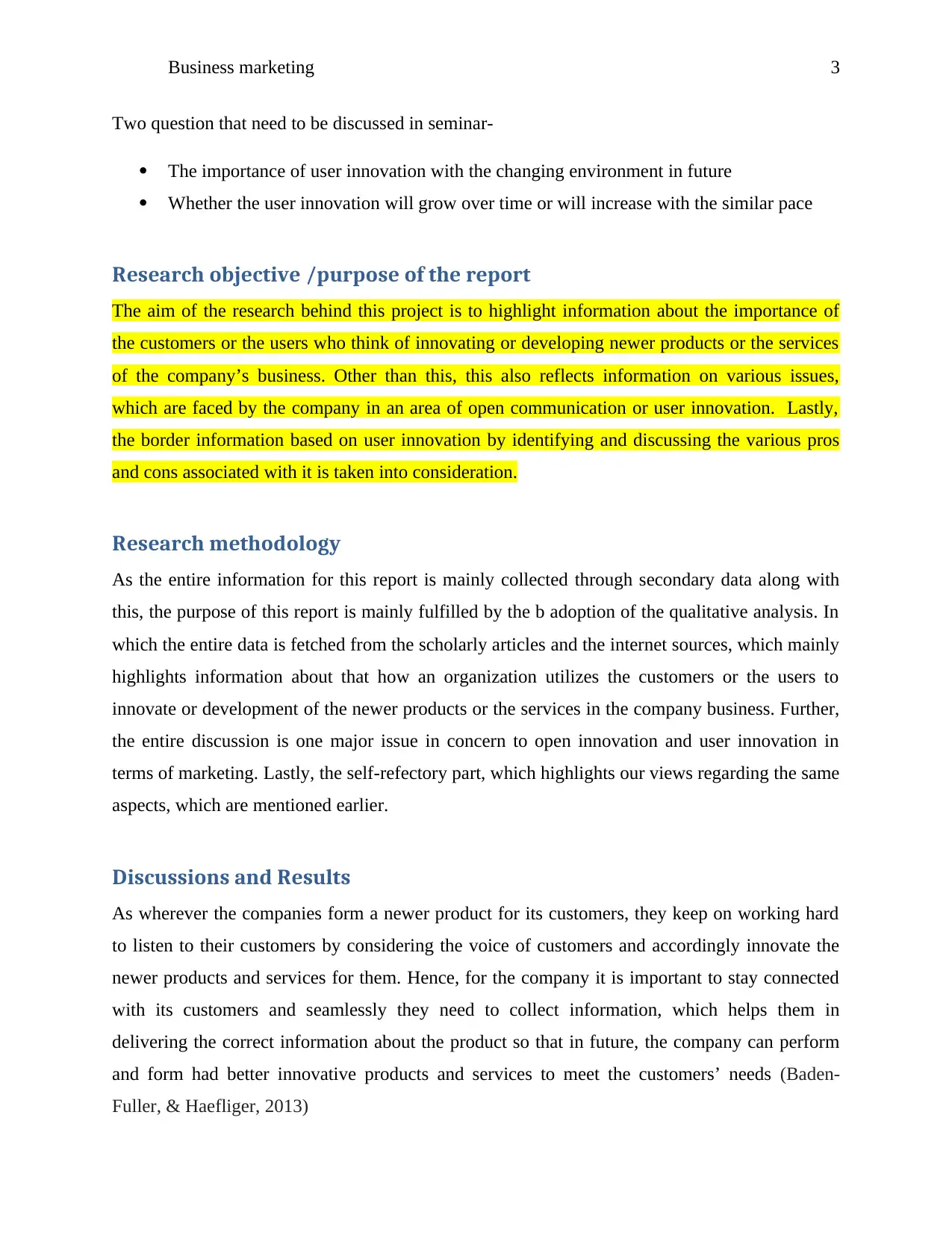
Business marketing 3
Two question that need to be discussed in seminar-
The importance of user innovation with the changing environment in future
Whether the user innovation will grow over time or will increase with the similar pace
Research objective /purpose of the report
The aim of the research behind this project is to highlight information about the importance of
the customers or the users who think of innovating or developing newer products or the services
of the company’s business. Other than this, this also reflects information on various issues,
which are faced by the company in an area of open communication or user innovation. Lastly,
the border information based on user innovation by identifying and discussing the various pros
and cons associated with it is taken into consideration.
Research methodology
As the entire information for this report is mainly collected through secondary data along with
this, the purpose of this report is mainly fulfilled by the b adoption of the qualitative analysis. In
which the entire data is fetched from the scholarly articles and the internet sources, which mainly
highlights information about that how an organization utilizes the customers or the users to
innovate or development of the newer products or the services in the company business. Further,
the entire discussion is one major issue in concern to open innovation and user innovation in
terms of marketing. Lastly, the self-refectory part, which highlights our views regarding the same
aspects, which are mentioned earlier.
Discussions and Results
As wherever the companies form a newer product for its customers, they keep on working hard
to listen to their customers by considering the voice of customers and accordingly innovate the
newer products and services for them. Hence, for the company it is important to stay connected
with its customers and seamlessly they need to collect information, which helps them in
delivering the correct information about the product so that in future, the company can perform
and form had better innovative products and services to meet the customers’ needs (Baden-
Fuller, & Haefliger, 2013)
Two question that need to be discussed in seminar-
The importance of user innovation with the changing environment in future
Whether the user innovation will grow over time or will increase with the similar pace
Research objective /purpose of the report
The aim of the research behind this project is to highlight information about the importance of
the customers or the users who think of innovating or developing newer products or the services
of the company’s business. Other than this, this also reflects information on various issues,
which are faced by the company in an area of open communication or user innovation. Lastly,
the border information based on user innovation by identifying and discussing the various pros
and cons associated with it is taken into consideration.
Research methodology
As the entire information for this report is mainly collected through secondary data along with
this, the purpose of this report is mainly fulfilled by the b adoption of the qualitative analysis. In
which the entire data is fetched from the scholarly articles and the internet sources, which mainly
highlights information about that how an organization utilizes the customers or the users to
innovate or development of the newer products or the services in the company business. Further,
the entire discussion is one major issue in concern to open innovation and user innovation in
terms of marketing. Lastly, the self-refectory part, which highlights our views regarding the same
aspects, which are mentioned earlier.
Discussions and Results
As wherever the companies form a newer product for its customers, they keep on working hard
to listen to their customers by considering the voice of customers and accordingly innovate the
newer products and services for them. Hence, for the company it is important to stay connected
with its customers and seamlessly they need to collect information, which helps them in
delivering the correct information about the product so that in future, the company can perform
and form had better innovative products and services to meet the customers’ needs (Baden-
Fuller, & Haefliger, 2013)
Paraphrase This Document
Need a fresh take? Get an instant paraphrase of this document with our AI Paraphraser
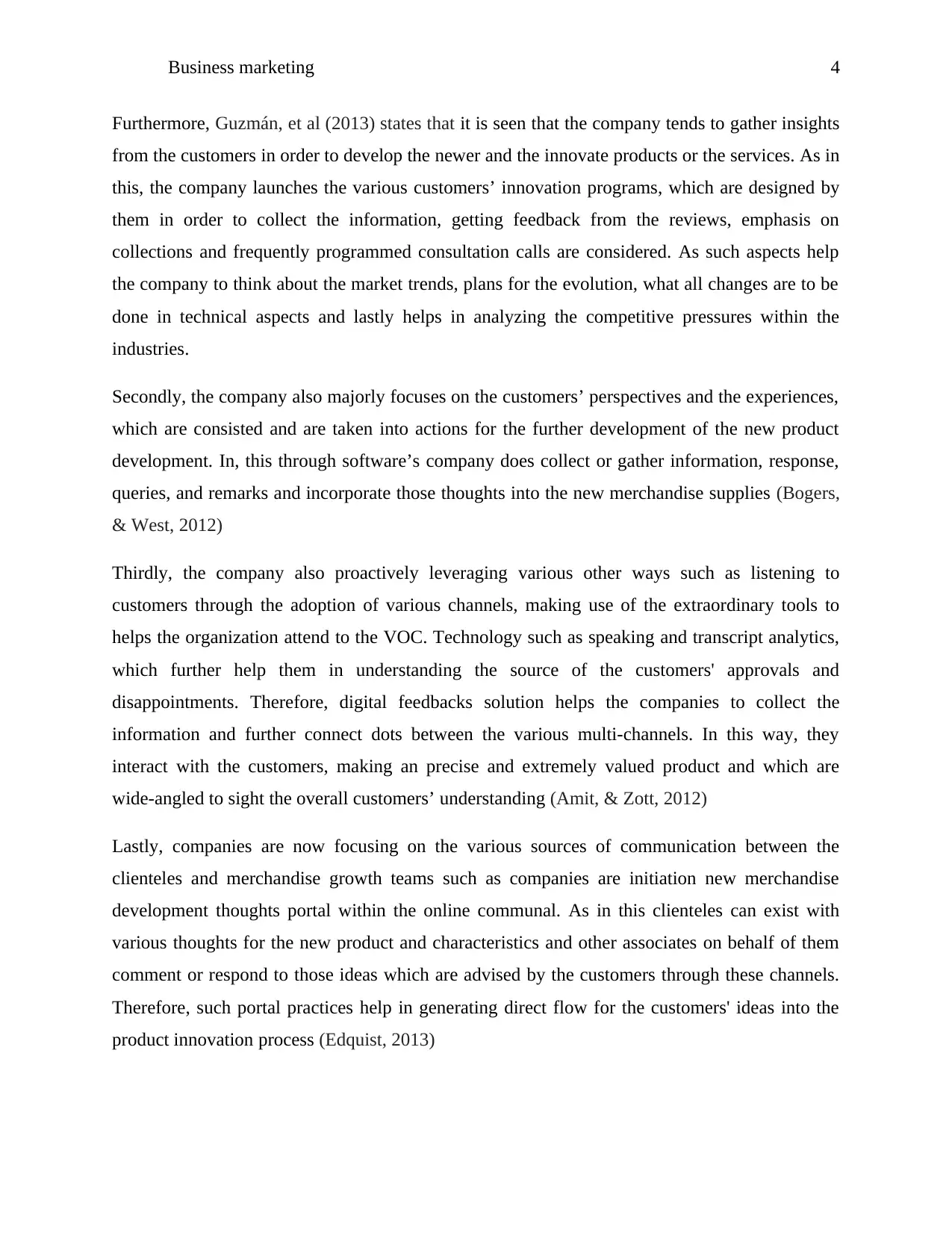
Business marketing 4
Furthermore, Guzmán, et al (2013) states that it is seen that the company tends to gather insights
from the customers in order to develop the newer and the innovate products or the services. As in
this, the company launches the various customers’ innovation programs, which are designed by
them in order to collect the information, getting feedback from the reviews, emphasis on
collections and frequently programmed consultation calls are considered. As such aspects help
the company to think about the market trends, plans for the evolution, what all changes are to be
done in technical aspects and lastly helps in analyzing the competitive pressures within the
industries.
Secondly, the company also majorly focuses on the customers’ perspectives and the experiences,
which are consisted and are taken into actions for the further development of the new product
development. In, this through software’s company does collect or gather information, response,
queries, and remarks and incorporate those thoughts into the new merchandise supplies (Bogers,
& West, 2012)
Thirdly, the company also proactively leveraging various other ways such as listening to
customers through the adoption of various channels, making use of the extraordinary tools to
helps the organization attend to the VOC. Technology such as speaking and transcript analytics,
which further help them in understanding the source of the customers' approvals and
disappointments. Therefore, digital feedbacks solution helps the companies to collect the
information and further connect dots between the various multi-channels. In this way, they
interact with the customers, making an precise and extremely valued product and which are
wide-angled to sight the overall customers’ understanding (Amit, & Zott, 2012)
Lastly, companies are now focusing on the various sources of communication between the
clienteles and merchandise growth teams such as companies are initiation new merchandise
development thoughts portal within the online communal. As in this clienteles can exist with
various thoughts for the new product and characteristics and other associates on behalf of them
comment or respond to those ideas which are advised by the customers through these channels.
Therefore, such portal practices help in generating direct flow for the customers' ideas into the
product innovation process (Edquist, 2013)
Furthermore, Guzmán, et al (2013) states that it is seen that the company tends to gather insights
from the customers in order to develop the newer and the innovate products or the services. As in
this, the company launches the various customers’ innovation programs, which are designed by
them in order to collect the information, getting feedback from the reviews, emphasis on
collections and frequently programmed consultation calls are considered. As such aspects help
the company to think about the market trends, plans for the evolution, what all changes are to be
done in technical aspects and lastly helps in analyzing the competitive pressures within the
industries.
Secondly, the company also majorly focuses on the customers’ perspectives and the experiences,
which are consisted and are taken into actions for the further development of the new product
development. In, this through software’s company does collect or gather information, response,
queries, and remarks and incorporate those thoughts into the new merchandise supplies (Bogers,
& West, 2012)
Thirdly, the company also proactively leveraging various other ways such as listening to
customers through the adoption of various channels, making use of the extraordinary tools to
helps the organization attend to the VOC. Technology such as speaking and transcript analytics,
which further help them in understanding the source of the customers' approvals and
disappointments. Therefore, digital feedbacks solution helps the companies to collect the
information and further connect dots between the various multi-channels. In this way, they
interact with the customers, making an precise and extremely valued product and which are
wide-angled to sight the overall customers’ understanding (Amit, & Zott, 2012)
Lastly, companies are now focusing on the various sources of communication between the
clienteles and merchandise growth teams such as companies are initiation new merchandise
development thoughts portal within the online communal. As in this clienteles can exist with
various thoughts for the new product and characteristics and other associates on behalf of them
comment or respond to those ideas which are advised by the customers through these channels.
Therefore, such portal practices help in generating direct flow for the customers' ideas into the
product innovation process (Edquist, 2013)
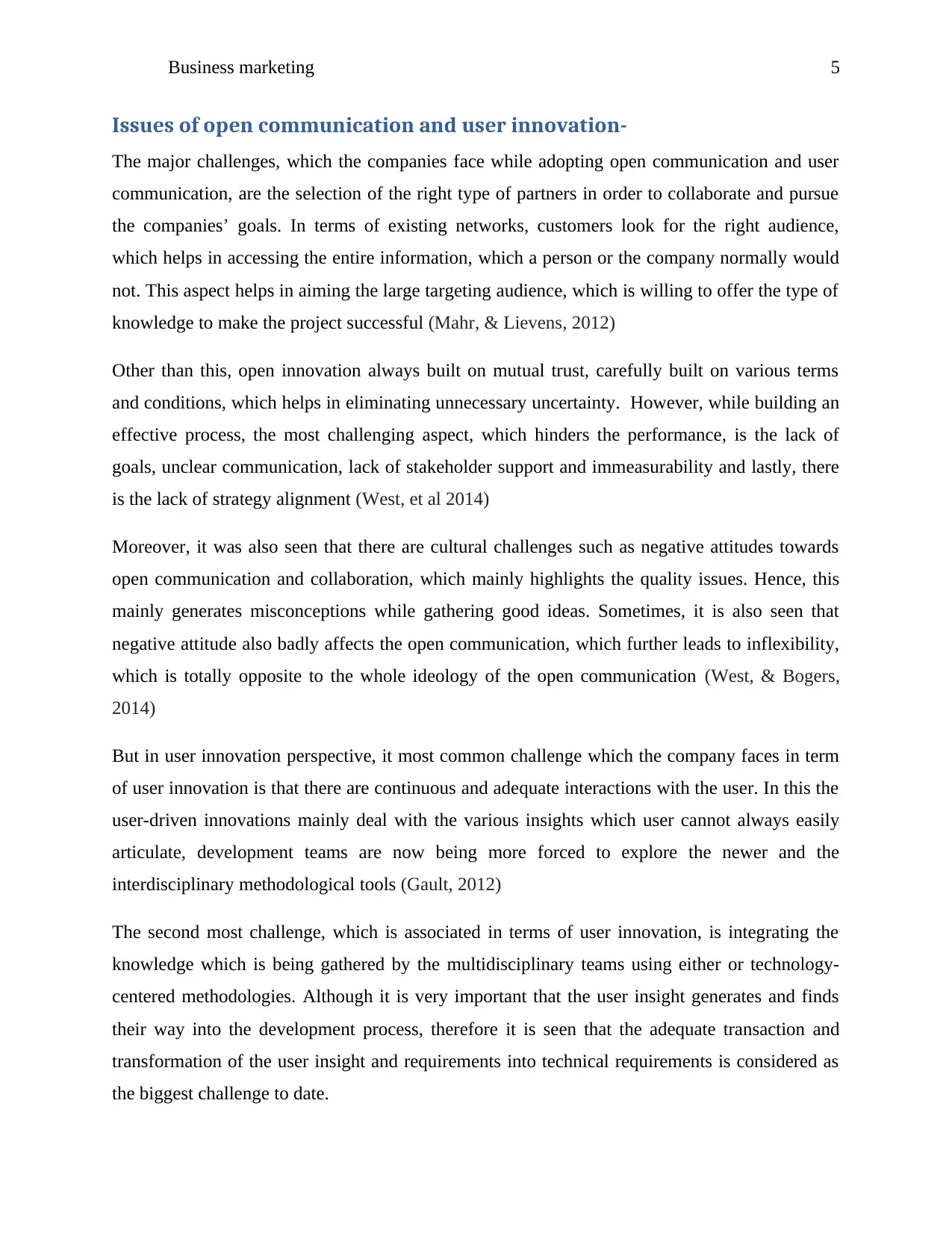
Business marketing 5
Issues of open communication and user innovation-
The major challenges, which the companies face while adopting open communication and user
communication, are the selection of the right type of partners in order to collaborate and pursue
the companies’ goals. In terms of existing networks, customers look for the right audience,
which helps in accessing the entire information, which a person or the company normally would
not. This aspect helps in aiming the large targeting audience, which is willing to offer the type of
knowledge to make the project successful (Mahr, & Lievens, 2012)
Other than this, open innovation always built on mutual trust, carefully built on various terms
and conditions, which helps in eliminating unnecessary uncertainty. However, while building an
effective process, the most challenging aspect, which hinders the performance, is the lack of
goals, unclear communication, lack of stakeholder support and immeasurability and lastly, there
is the lack of strategy alignment (West, et al 2014)
Moreover, it was also seen that there are cultural challenges such as negative attitudes towards
open communication and collaboration, which mainly highlights the quality issues. Hence, this
mainly generates misconceptions while gathering good ideas. Sometimes, it is also seen that
negative attitude also badly affects the open communication, which further leads to inflexibility,
which is totally opposite to the whole ideology of the open communication (West, & Bogers,
2014)
But in user innovation perspective, it most common challenge which the company faces in term
of user innovation is that there are continuous and adequate interactions with the user. In this the
user-driven innovations mainly deal with the various insights which user cannot always easily
articulate, development teams are now being more forced to explore the newer and the
interdisciplinary methodological tools (Gault, 2012)
The second most challenge, which is associated in terms of user innovation, is integrating the
knowledge which is being gathered by the multidisciplinary teams using either or technology-
centered methodologies. Although it is very important that the user insight generates and finds
their way into the development process, therefore it is seen that the adequate transaction and
transformation of the user insight and requirements into technical requirements is considered as
the biggest challenge to date.
Issues of open communication and user innovation-
The major challenges, which the companies face while adopting open communication and user
communication, are the selection of the right type of partners in order to collaborate and pursue
the companies’ goals. In terms of existing networks, customers look for the right audience,
which helps in accessing the entire information, which a person or the company normally would
not. This aspect helps in aiming the large targeting audience, which is willing to offer the type of
knowledge to make the project successful (Mahr, & Lievens, 2012)
Other than this, open innovation always built on mutual trust, carefully built on various terms
and conditions, which helps in eliminating unnecessary uncertainty. However, while building an
effective process, the most challenging aspect, which hinders the performance, is the lack of
goals, unclear communication, lack of stakeholder support and immeasurability and lastly, there
is the lack of strategy alignment (West, et al 2014)
Moreover, it was also seen that there are cultural challenges such as negative attitudes towards
open communication and collaboration, which mainly highlights the quality issues. Hence, this
mainly generates misconceptions while gathering good ideas. Sometimes, it is also seen that
negative attitude also badly affects the open communication, which further leads to inflexibility,
which is totally opposite to the whole ideology of the open communication (West, & Bogers,
2014)
But in user innovation perspective, it most common challenge which the company faces in term
of user innovation is that there are continuous and adequate interactions with the user. In this the
user-driven innovations mainly deal with the various insights which user cannot always easily
articulate, development teams are now being more forced to explore the newer and the
interdisciplinary methodological tools (Gault, 2012)
The second most challenge, which is associated in terms of user innovation, is integrating the
knowledge which is being gathered by the multidisciplinary teams using either or technology-
centered methodologies. Although it is very important that the user insight generates and finds
their way into the development process, therefore it is seen that the adequate transaction and
transformation of the user insight and requirements into technical requirements is considered as
the biggest challenge to date.
⊘ This is a preview!⊘
Do you want full access?
Subscribe today to unlock all pages.

Trusted by 1+ million students worldwide
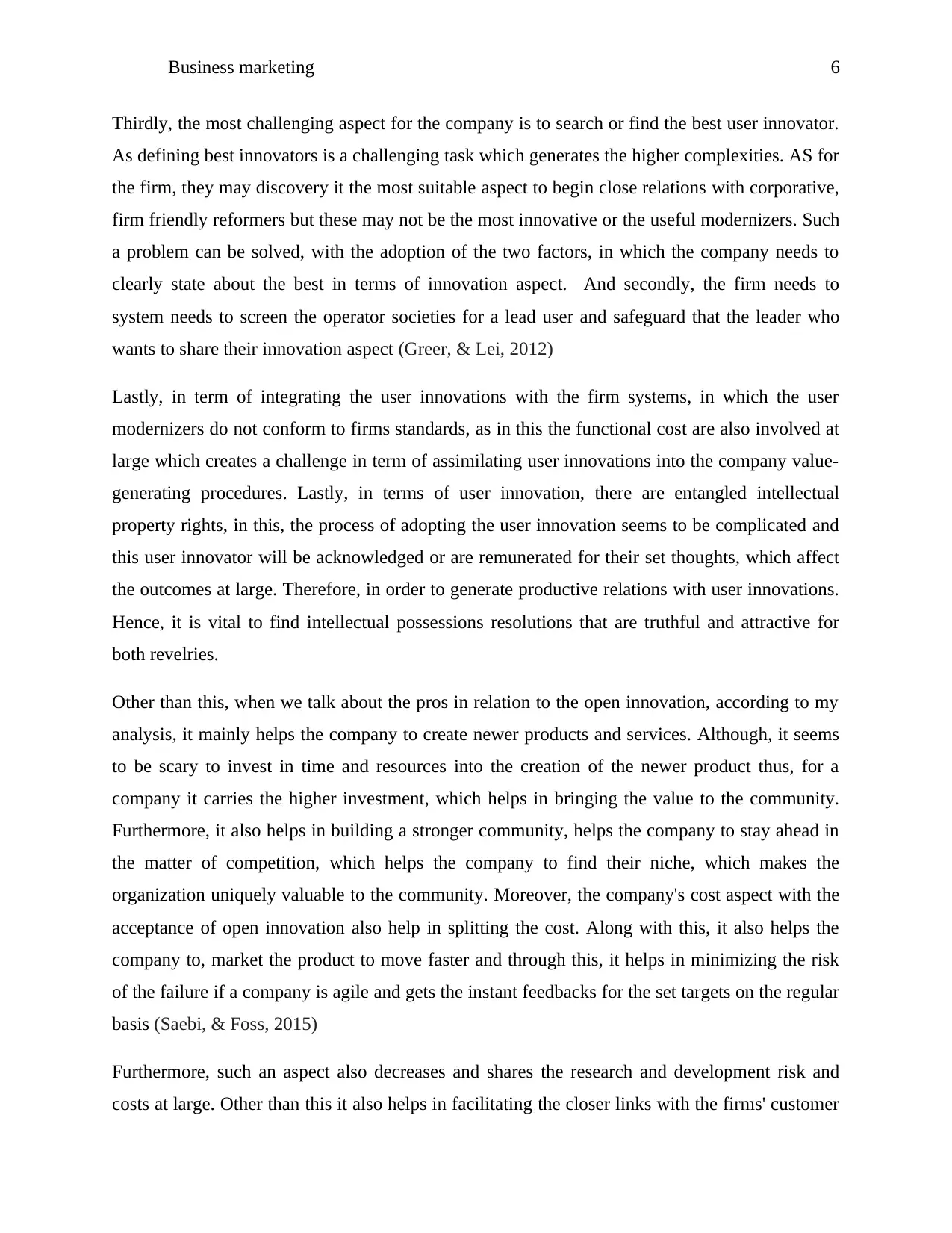
Business marketing 6
Thirdly, the most challenging aspect for the company is to search or find the best user innovator.
As defining best innovators is a challenging task which generates the higher complexities. AS for
the firm, they may discovery it the most suitable aspect to begin close relations with corporative,
firm friendly reformers but these may not be the most innovative or the useful modernizers. Such
a problem can be solved, with the adoption of the two factors, in which the company needs to
clearly state about the best in terms of innovation aspect. And secondly, the firm needs to
system needs to screen the operator societies for a lead user and safeguard that the leader who
wants to share their innovation aspect (Greer, & Lei, 2012)
Lastly, in term of integrating the user innovations with the firm systems, in which the user
modernizers do not conform to firms standards, as in this the functional cost are also involved at
large which creates a challenge in term of assimilating user innovations into the company value-
generating procedures. Lastly, in terms of user innovation, there are entangled intellectual
property rights, in this, the process of adopting the user innovation seems to be complicated and
this user innovator will be acknowledged or are remunerated for their set thoughts, which affect
the outcomes at large. Therefore, in order to generate productive relations with user innovations.
Hence, it is vital to find intellectual possessions resolutions that are truthful and attractive for
both revelries.
Other than this, when we talk about the pros in relation to the open innovation, according to my
analysis, it mainly helps the company to create newer products and services. Although, it seems
to be scary to invest in time and resources into the creation of the newer product thus, for a
company it carries the higher investment, which helps in bringing the value to the community.
Furthermore, it also helps in building a stronger community, helps the company to stay ahead in
the matter of competition, which helps the company to find their niche, which makes the
organization uniquely valuable to the community. Moreover, the company's cost aspect with the
acceptance of open innovation also help in splitting the cost. Along with this, it also helps the
company to, market the product to move faster and through this, it helps in minimizing the risk
of the failure if a company is agile and gets the instant feedbacks for the set targets on the regular
basis (Saebi, & Foss, 2015)
Furthermore, such an aspect also decreases and shares the research and development risk and
costs at large. Other than this it also helps in facilitating the closer links with the firms' customer
Thirdly, the most challenging aspect for the company is to search or find the best user innovator.
As defining best innovators is a challenging task which generates the higher complexities. AS for
the firm, they may discovery it the most suitable aspect to begin close relations with corporative,
firm friendly reformers but these may not be the most innovative or the useful modernizers. Such
a problem can be solved, with the adoption of the two factors, in which the company needs to
clearly state about the best in terms of innovation aspect. And secondly, the firm needs to
system needs to screen the operator societies for a lead user and safeguard that the leader who
wants to share their innovation aspect (Greer, & Lei, 2012)
Lastly, in term of integrating the user innovations with the firm systems, in which the user
modernizers do not conform to firms standards, as in this the functional cost are also involved at
large which creates a challenge in term of assimilating user innovations into the company value-
generating procedures. Lastly, in terms of user innovation, there are entangled intellectual
property rights, in this, the process of adopting the user innovation seems to be complicated and
this user innovator will be acknowledged or are remunerated for their set thoughts, which affect
the outcomes at large. Therefore, in order to generate productive relations with user innovations.
Hence, it is vital to find intellectual possessions resolutions that are truthful and attractive for
both revelries.
Other than this, when we talk about the pros in relation to the open innovation, according to my
analysis, it mainly helps the company to create newer products and services. Although, it seems
to be scary to invest in time and resources into the creation of the newer product thus, for a
company it carries the higher investment, which helps in bringing the value to the community.
Furthermore, it also helps in building a stronger community, helps the company to stay ahead in
the matter of competition, which helps the company to find their niche, which makes the
organization uniquely valuable to the community. Moreover, the company's cost aspect with the
acceptance of open innovation also help in splitting the cost. Along with this, it also helps the
company to, market the product to move faster and through this, it helps in minimizing the risk
of the failure if a company is agile and gets the instant feedbacks for the set targets on the regular
basis (Saebi, & Foss, 2015)
Furthermore, such an aspect also decreases and shares the research and development risk and
costs at large. Other than this it also helps in facilitating the closer links with the firms' customer
Paraphrase This Document
Need a fresh take? Get an instant paraphrase of this document with our AI Paraphraser
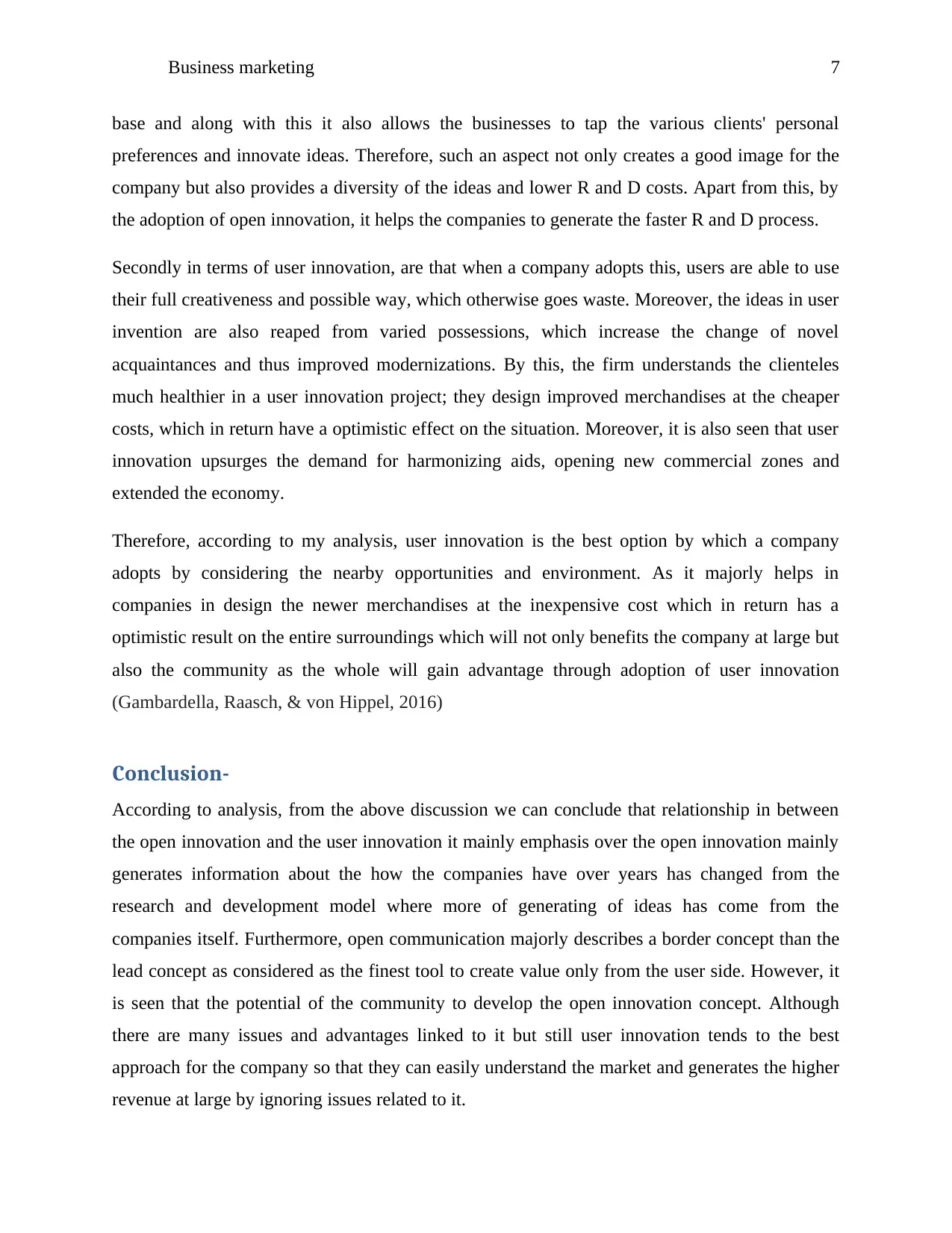
Business marketing 7
base and along with this it also allows the businesses to tap the various clients' personal
preferences and innovate ideas. Therefore, such an aspect not only creates a good image for the
company but also provides a diversity of the ideas and lower R and D costs. Apart from this, by
the adoption of open innovation, it helps the companies to generate the faster R and D process.
Secondly in terms of user innovation, are that when a company adopts this, users are able to use
their full creativeness and possible way, which otherwise goes waste. Moreover, the ideas in user
invention are also reaped from varied possessions, which increase the change of novel
acquaintances and thus improved modernizations. By this, the firm understands the clienteles
much healthier in a user innovation project; they design improved merchandises at the cheaper
costs, which in return have a optimistic effect on the situation. Moreover, it is also seen that user
innovation upsurges the demand for harmonizing aids, opening new commercial zones and
extended the economy.
Therefore, according to my analysis, user innovation is the best option by which a company
adopts by considering the nearby opportunities and environment. As it majorly helps in
companies in design the newer merchandises at the inexpensive cost which in return has a
optimistic result on the entire surroundings which will not only benefits the company at large but
also the community as the whole will gain advantage through adoption of user innovation
(Gambardella, Raasch, & von Hippel, 2016)
Conclusion-
According to analysis, from the above discussion we can conclude that relationship in between
the open innovation and the user innovation it mainly emphasis over the open innovation mainly
generates information about the how the companies have over years has changed from the
research and development model where more of generating of ideas has come from the
companies itself. Furthermore, open communication majorly describes a border concept than the
lead concept as considered as the finest tool to create value only from the user side. However, it
is seen that the potential of the community to develop the open innovation concept. Although
there are many issues and advantages linked to it but still user innovation tends to the best
approach for the company so that they can easily understand the market and generates the higher
revenue at large by ignoring issues related to it.
base and along with this it also allows the businesses to tap the various clients' personal
preferences and innovate ideas. Therefore, such an aspect not only creates a good image for the
company but also provides a diversity of the ideas and lower R and D costs. Apart from this, by
the adoption of open innovation, it helps the companies to generate the faster R and D process.
Secondly in terms of user innovation, are that when a company adopts this, users are able to use
their full creativeness and possible way, which otherwise goes waste. Moreover, the ideas in user
invention are also reaped from varied possessions, which increase the change of novel
acquaintances and thus improved modernizations. By this, the firm understands the clienteles
much healthier in a user innovation project; they design improved merchandises at the cheaper
costs, which in return have a optimistic effect on the situation. Moreover, it is also seen that user
innovation upsurges the demand for harmonizing aids, opening new commercial zones and
extended the economy.
Therefore, according to my analysis, user innovation is the best option by which a company
adopts by considering the nearby opportunities and environment. As it majorly helps in
companies in design the newer merchandises at the inexpensive cost which in return has a
optimistic result on the entire surroundings which will not only benefits the company at large but
also the community as the whole will gain advantage through adoption of user innovation
(Gambardella, Raasch, & von Hippel, 2016)
Conclusion-
According to analysis, from the above discussion we can conclude that relationship in between
the open innovation and the user innovation it mainly emphasis over the open innovation mainly
generates information about the how the companies have over years has changed from the
research and development model where more of generating of ideas has come from the
companies itself. Furthermore, open communication majorly describes a border concept than the
lead concept as considered as the finest tool to create value only from the user side. However, it
is seen that the potential of the community to develop the open innovation concept. Although
there are many issues and advantages linked to it but still user innovation tends to the best
approach for the company so that they can easily understand the market and generates the higher
revenue at large by ignoring issues related to it.

Business marketing 8
⊘ This is a preview!⊘
Do you want full access?
Subscribe today to unlock all pages.

Trusted by 1+ million students worldwide
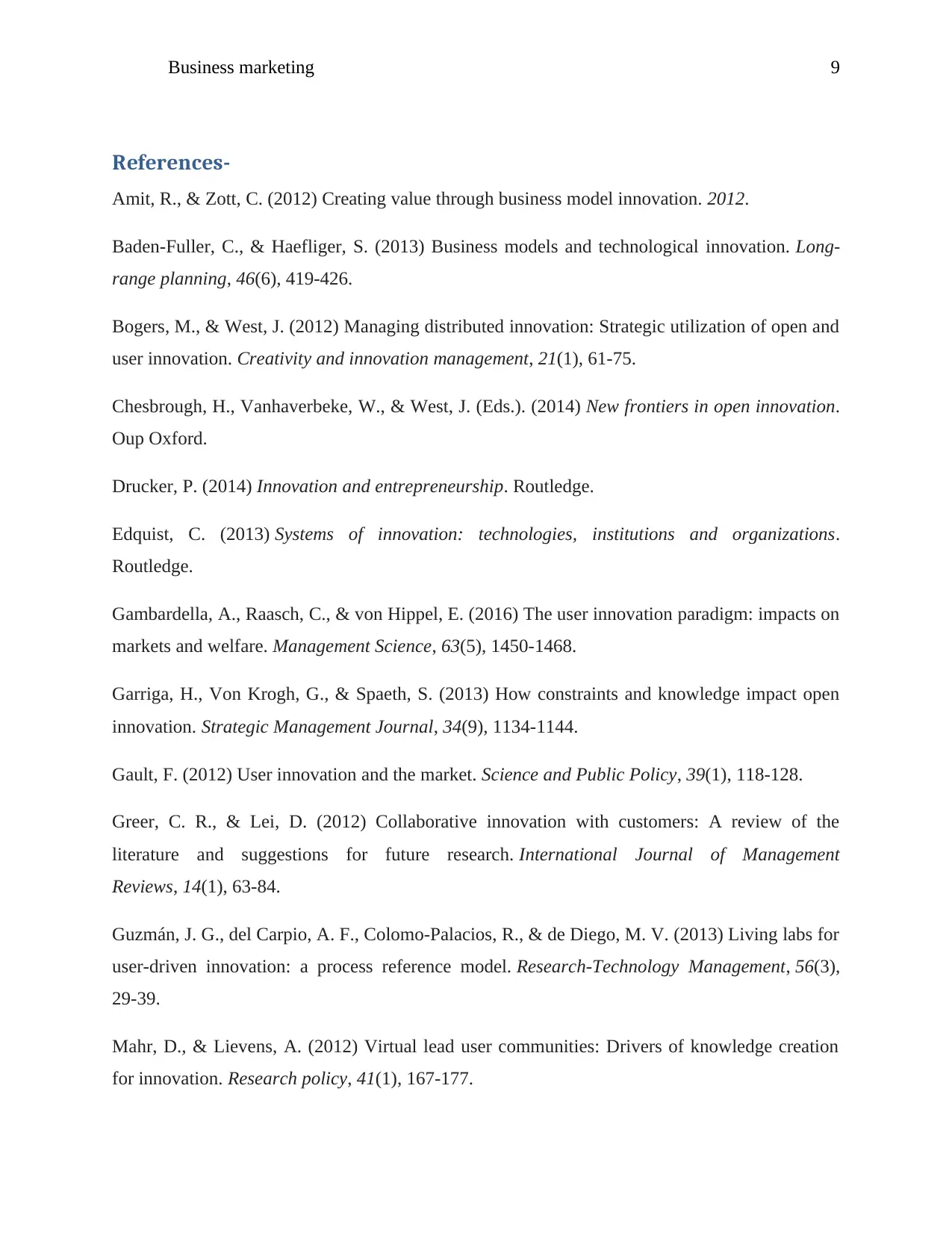
Business marketing 9
References-
Amit, R., & Zott, C. (2012) Creating value through business model innovation. 2012.
Baden-Fuller, C., & Haefliger, S. (2013) Business models and technological innovation. Long-
range planning, 46(6), 419-426.
Bogers, M., & West, J. (2012) Managing distributed innovation: Strategic utilization of open and
user innovation. Creativity and innovation management, 21(1), 61-75.
Chesbrough, H., Vanhaverbeke, W., & West, J. (Eds.). (2014) New frontiers in open innovation.
Oup Oxford.
Drucker, P. (2014) Innovation and entrepreneurship. Routledge.
Edquist, C. (2013) Systems of innovation: technologies, institutions and organizations.
Routledge.
Gambardella, A., Raasch, C., & von Hippel, E. (2016) The user innovation paradigm: impacts on
markets and welfare. Management Science, 63(5), 1450-1468.
Garriga, H., Von Krogh, G., & Spaeth, S. (2013) How constraints and knowledge impact open
innovation. Strategic Management Journal, 34(9), 1134-1144.
Gault, F. (2012) User innovation and the market. Science and Public Policy, 39(1), 118-128.
Greer, C. R., & Lei, D. (2012) Collaborative innovation with customers: A review of the
literature and suggestions for future research. International Journal of Management
Reviews, 14(1), 63-84.
Guzmán, J. G., del Carpio, A. F., Colomo-Palacios, R., & de Diego, M. V. (2013) Living labs for
user-driven innovation: a process reference model. Research-Technology Management, 56(3),
29-39.
Mahr, D., & Lievens, A. (2012) Virtual lead user communities: Drivers of knowledge creation
for innovation. Research policy, 41(1), 167-177.
References-
Amit, R., & Zott, C. (2012) Creating value through business model innovation. 2012.
Baden-Fuller, C., & Haefliger, S. (2013) Business models and technological innovation. Long-
range planning, 46(6), 419-426.
Bogers, M., & West, J. (2012) Managing distributed innovation: Strategic utilization of open and
user innovation. Creativity and innovation management, 21(1), 61-75.
Chesbrough, H., Vanhaverbeke, W., & West, J. (Eds.). (2014) New frontiers in open innovation.
Oup Oxford.
Drucker, P. (2014) Innovation and entrepreneurship. Routledge.
Edquist, C. (2013) Systems of innovation: technologies, institutions and organizations.
Routledge.
Gambardella, A., Raasch, C., & von Hippel, E. (2016) The user innovation paradigm: impacts on
markets and welfare. Management Science, 63(5), 1450-1468.
Garriga, H., Von Krogh, G., & Spaeth, S. (2013) How constraints and knowledge impact open
innovation. Strategic Management Journal, 34(9), 1134-1144.
Gault, F. (2012) User innovation and the market. Science and Public Policy, 39(1), 118-128.
Greer, C. R., & Lei, D. (2012) Collaborative innovation with customers: A review of the
literature and suggestions for future research. International Journal of Management
Reviews, 14(1), 63-84.
Guzmán, J. G., del Carpio, A. F., Colomo-Palacios, R., & de Diego, M. V. (2013) Living labs for
user-driven innovation: a process reference model. Research-Technology Management, 56(3),
29-39.
Mahr, D., & Lievens, A. (2012) Virtual lead user communities: Drivers of knowledge creation
for innovation. Research policy, 41(1), 167-177.
Paraphrase This Document
Need a fresh take? Get an instant paraphrase of this document with our AI Paraphraser
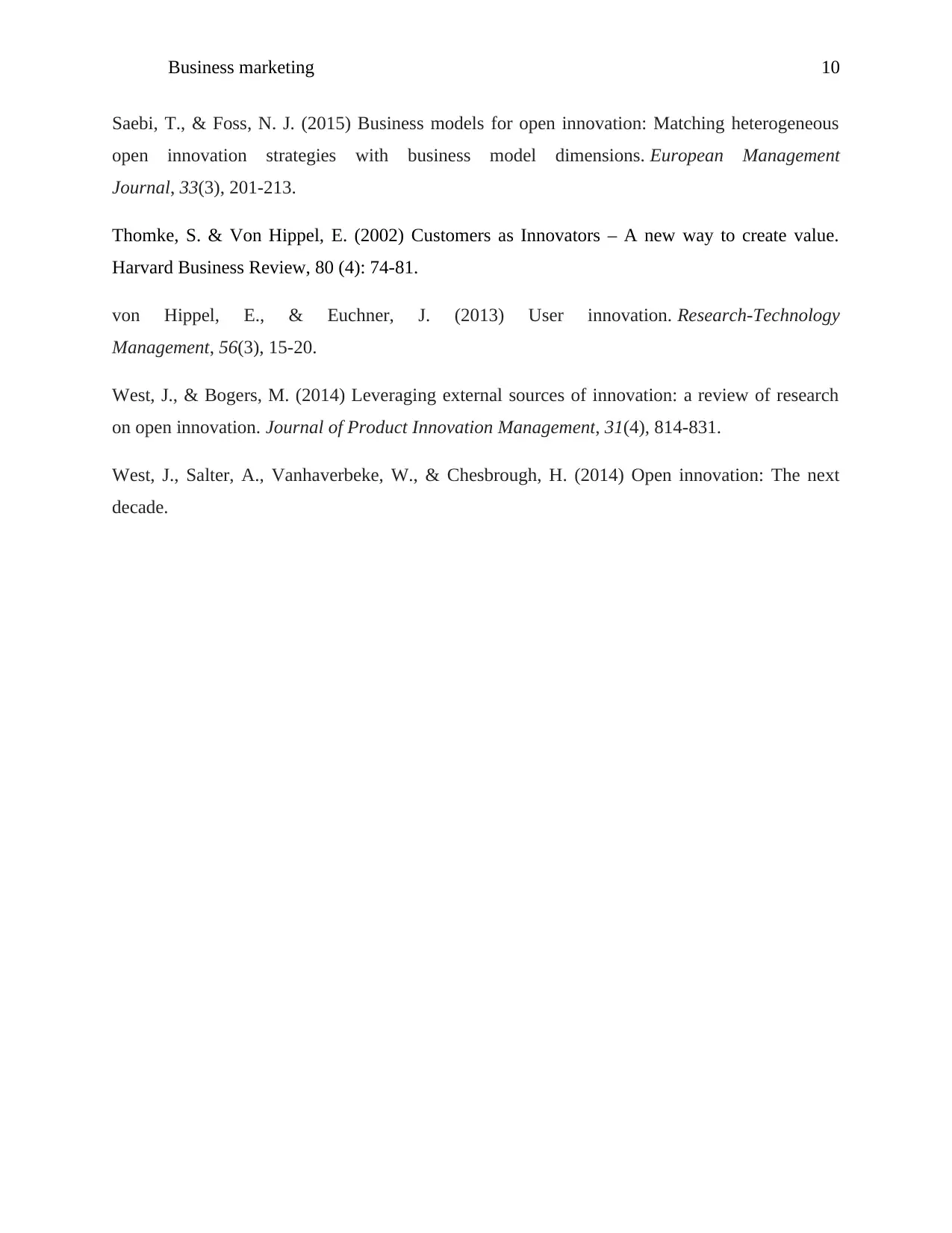
Business marketing 10
Saebi, T., & Foss, N. J. (2015) Business models for open innovation: Matching heterogeneous
open innovation strategies with business model dimensions. European Management
Journal, 33(3), 201-213.
Thomke, S. & Von Hippel, E. (2002) Customers as Innovators – A new way to create value.
Harvard Business Review, 80 (4): 74-81.
von Hippel, E., & Euchner, J. (2013) User innovation. Research-Technology
Management, 56(3), 15-20.
West, J., & Bogers, M. (2014) Leveraging external sources of innovation: a review of research
on open innovation. Journal of Product Innovation Management, 31(4), 814-831.
West, J., Salter, A., Vanhaverbeke, W., & Chesbrough, H. (2014) Open innovation: The next
decade.
Saebi, T., & Foss, N. J. (2015) Business models for open innovation: Matching heterogeneous
open innovation strategies with business model dimensions. European Management
Journal, 33(3), 201-213.
Thomke, S. & Von Hippel, E. (2002) Customers as Innovators – A new way to create value.
Harvard Business Review, 80 (4): 74-81.
von Hippel, E., & Euchner, J. (2013) User innovation. Research-Technology
Management, 56(3), 15-20.
West, J., & Bogers, M. (2014) Leveraging external sources of innovation: a review of research
on open innovation. Journal of Product Innovation Management, 31(4), 814-831.
West, J., Salter, A., Vanhaverbeke, W., & Chesbrough, H. (2014) Open innovation: The next
decade.
1 out of 11
Related Documents
Your All-in-One AI-Powered Toolkit for Academic Success.
+13062052269
info@desklib.com
Available 24*7 on WhatsApp / Email
![[object Object]](/_next/static/media/star-bottom.7253800d.svg)
Unlock your academic potential
Copyright © 2020–2025 A2Z Services. All Rights Reserved. Developed and managed by ZUCOL.





